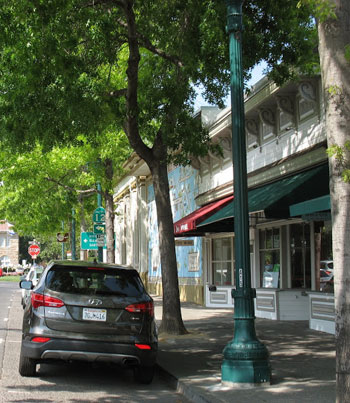Preserving Sonoma’s town character is a challenge. Describing that character generates a wide range of opinion; our world is complex and changeable, and Sonoma is not immune from the tidal forces of cultural and social transformation taking place around us. That said, however, certain characteristics of Sonoma are embedded deeply in its history, and that history includes both physical and social structures.
Physical structures impact social structures, and of the two, the physical changes which take place in the community generally have the greater, longer-lasting effects. For example, the eight-acre Plaza at the heart of our downtown provides space and environment, which stimulates social interaction, the comfortable gathering of crowds, children at play, picnics, couples strolling hand-in-hand, and even sunbathers. If the physical structure of the Plaza did not exist, the varied social interactions and activities would obviously be different.
The same can be said for the layout of our streets, the size and scale of buildings, and their relationship to other structures and neighborhoods. The interplay of structures and social forms cannot be divided; physical structures are a material manifestation of society and the two are bound together inseparably. It is for this reason that planning is an integral part of the approval of physical structures – not just for reasons of safety – but in a town like Sonoma for reasons of character. Once built, structures leave an indelible footprint on social forms.
Social structures are not entirely dependent upon physical structure, however, and also emerge within the context of changing habits, lifestyles, values, economics, and other varied elements of culture. Advertising, for example, is an element of culture not primarily dependent upon physical structures, but rather the emotional and subjective mental experience of individuals. Its intent is to change behavior, in most cases economic behavior related to choices in purchasing. The erosion of “brick and mortar” retailing due to online shopping is one manifestation of the combined power of technology and advertising. Thus social change affects the use of previously built physical structures.
The recently revived Williams Sonoma store on Broadway provides an interesting example of the interplay of physical and social change. What was proposed as a unique, one-of-a-kind outlet of the enormously successful retail chain – a sort of Chuck Williams “museum” rather than its typical retail approach – recently applied for modifications of its use permit to allow a variety of events throughout the year, ranging from small to large. For the medium-sized to large events, the retailer proposed offering valet parking, in recognition of the impacts of more intense activity at their location.
Offering valet parking on a regular basis is a decidedly urbanized activity, the sort of thing that’s normal in front of Jardiniere, a San Francisco restaurant down the block from the Opera House, but represents an intensity of urbanism to which Sonoma is vulnerable. In large cities, the hubbub, crowds and fast pace of life is part of its sense of place, but in small-town Sonoma is misplaced. Whatever the impulse offering valet parking for recurrent major events is out of step with Sonoma’s historic character, making commonplace something that should remain rare and special.
Changed physical structures sometimes create the impulse for social changes which alter neighborhood character or even entire towns. Sonoma has become more sophisticated, but if preserving its character means anything, it means small, quiet and slower-paced.
